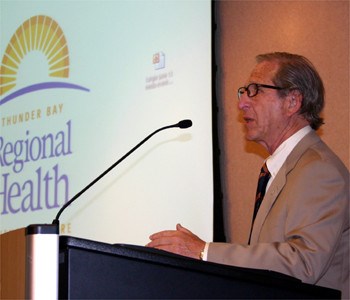The Thunder Bay Regional Health Sciences Centre received the green light for a second cardiac catheterization laboratory from the Ministry of Health and Long-Term Care Friday.
Thunder Bay-Atikokan MPP Bill Mauro made the announcement also stating the province would provide $8.4 million of the $12 million needed for the project. The hospital will cover the rest; the Thunder Bay Regional Health Sciences Foundation has already raised $2.8 million for the second lab.
“The tenders have gone out; they’ve been received … the government has signed off,” he said, adding construction should start shortly with the lab ready to go by next summer.
For the past 18 months, the hospital has been conducting 500 to 600 angioplasty procedures in one lab, which vice president of medicine, cardiology, mental health and maternal child services Lori Marshall said has meant extended hours and weekends.
“We’ve really been putting it to the test,” she said. “Most would say you need two l abs in order to operate a quality program and being able to do it on a 24/7 basis.”
The second cardiac cath lab will allow the hospital to do just that.
“Right now if you had a heart attack during the evening or night hours, it would really just be by luck if we were able to get you in and find a tem to work with you,” she said. “What this will allow us to do is have that operational and be able to respond immediately to those needs.”
The program’s medical director Dr. Mark Henderson said the addition of the lab and also of the recent recruitment of a second interventional cardiologist, Dr. Ian Billingsley, will relieve a lot of pressure for himself and his team.
“Right now we work very long hours in the one room we have,” he said. “If an emergency case comes in and we’re already doing a case, we can’t really get to the emergency cases as quickly as possible or if the machine breaks down, which it does occasionally, or it’s being serviced … then we just can’t get to the patient very quickly. With tow labs, the chances of both labs being busy at any one time is much less. We’ll be able to do a better job at looking at the true emergency cases coming through.”
Mauro gave the news of the second lab while the centre was celebrating a passing grade from the Ministry of Health’s standalone angioplasty program expert panel.
With the program being the most remote in Canada, with the closest full-service cardiac centre more than 200 miles away, the expert panel was created to monitor the program’s safety, effectiveness and sustainability.
Panel chair Dr. Bernard Goldman said he figured the hospital would work well, but he never dreamed it would do as well as it has.
“Their impact on care here is tremendous,” he said. “People can get care in an urgent situation without having to lave their home base. They basically get care on the same day as they get their diagnostic angiogram.”
He added the program met all standards and expectations with extremely low risk.
Marshall said she is delighted with the recommendations and report from the panel.“What this does is validate us as a program and says from a quality, efficacy and safety standpoint we are second to none.”
